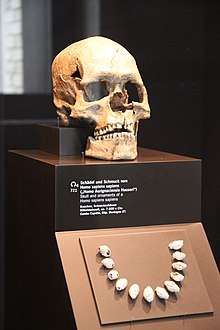Combe-Capelle
Combe-Capelle is a Paleolithic and Epipaleolithic site situated in the Couze valley in the Périgord region of southern France. Henri-Marc Ami carried out excavations in the area from the late 1920s until his death in 1931.

The famous Homo sapiens fossil from Combe-Capelle, discovered in 1909 was sold to the Museum für Völkerkunde, Berlin, in 1910. It was for a long time considered to be 30,000 years old, an Upper Paleolithic Cro-Magnon man and one of the oldest finds of modern humans in Europe, formerly classified as Homo aurignaciensis hauseri. [1] This was revised in a 2011 study, which dated collagen from a tooth of the skull in Berlin with accelerator mass spectrometry. The fossil was found to date to the early Holocene (Mesolithic Europe), at 9,500 years old.[2]
See also
| Wikimedia Commons has media related to Combe Capelle. |
References
- Robert Alexander Stewart, Macalister, A text-book of European archaeology (1921), p. 359. Verhandlung der geologischen Reichsanstalt (1909), p. 302. Georg Wilke, "Die neue Skelettfund des Homo auri-gnaciensis Hauseri" (Mannus 1 [1909], p. 252); G. Kossinna. "Zum Homo aurignaciensis" (Mannus 2 [1910], p. 169).
- "7601–7547 cal BC, 95.4%" Almut Hoffmann et al.: The Homo aurignaciensis hauseri from Combe-Capelle - A Mesolithic burial. Journal of Human Evolution 61(2), 2011, S. 211–214 doi:10.1016/j.jhevol.2011.03.001.